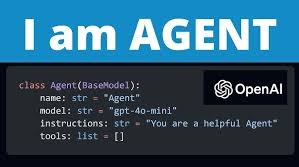
Introduction:
This comprehensive discussion explores OpenAI’s cutting-edge multi-agent code example, offering an in-depth look at the key features and complex implementation details of AI agents. The presenter carefully breaks down the concept of agents, explaining their core components and how they interact within a sophisticated multi-agent system. This presentation introduces the fundamental building blocks of AI agents and sheds light on the intricate network of interactions that allow these agents to collaborate effectively in solving complex tasks.
The presenter examines the structure of individual agents, their specialized roles, and their available tools. This approach paints a clear picture of how these digital entities work together, smoothly switching between tasks and sharing information to achieve common goals. This detailed explanation forms a foundation for understanding both the potential and limitations of multi-agent systems in the rapidly evolving field of artificial intelligence.
AI Multi-Agents: A Deep Dive
AI Multi-Agents are systems where multiple autonomous agents interact with each other and their environment to achieve common or competing goals. They’re crucial in fields like robotics, game theory, and economics.
Key Features
- Autonomy: Agents operate independently, making decisions based on their own perception and internal state.
- Interaction: Agents interact with each other, influencing each other’s behavior and decisions.
- Environment: Agents exist within an environment that can be static or dynamic, affecting their actions and perceptions.
- Goal-Oriented: Agents have specific goals they aim to achieve, which may be individual or shared.
Complex Implementation Details
- Agent Architecture:
- Reactive Agents: Respond directly to sensory inputs without internal state.
- Deliberative Agents: Reason and plan before acting, using internal models of the world.
- Hybrid Agents: Combine reactive and deliberative approaches for a balance of efficiency and flexibility.
- Communication:
- Language: Agents may use natural or artificial languages to exchange information.
- Non-verbal Communication: Gestures, actions, or signals can convey meaning.
- Communication Protocols: Rules and conventions govern how agents interact.
- Cooperation and Competition:
- Game Theory: Models interactions between agents using concepts like cooperative games and competitive games.
- Coordination and Negotiation: Agents may need to coordinate their actions or negotiate to achieve shared goals.
- Learning and Adaptation:
- Reinforcement Learning: Agents learn from their interactions with the environment, adjusting their behavior to maximize rewards.
- Evolutionary Algorithms: Agents can evolve over time, adapting to changing conditions.
- Uncertainty and Incompleteness:
- Uncertainty Handling: Agents must deal with uncertainty in their perceptions and knowledge.
- Incomplete Information: Agents may have limited information about the environment or other agents.
- Scalability:
- Distributed Systems: As the number of agents increases, systems must be designed to scale efficiently.
- Parallel Processing: Tasks can be distributed across multiple processors to improve performance.
Real-World Applications
- Robotics: Autonomous robots that collaborate to accomplish tasks.
- Video Games: Non-player characters (NPCs) that interact with players and each other.
- Economics: Modeling markets and economic systems as interactions between agents.
- Traffic Control: Coordinating the movement of vehicles to optimize traffic flow.
- Healthcare: Simulating the spread of diseases or optimizing healthcare resource allocation.
Challenges and Future Directions
- Complexity: Designing and implementing multi-agent systems can be complex, especially for large-scale systems.
- Scalability: Ensuring that multi-agent systems can handle a large number of agents and interactions.
- Uncertainty: Dealing with uncertainty and incompleteness in the environment and agent knowledge.
- Ethics: Addressing ethical concerns related to the behavior of autonomous agents.
- Interoperability: Enabling seamless communication and interaction between agents from different systems.
As AI continues to advance, multi-agent systems will play an increasingly important role in various domains, offering opportunities for innovation and addressing complex challenges.
Video about Multi-Agent Code explained with OpenAI:
Related Sections for the above video:
- Agent Definition: The video explains that an agent consists of a language model, instructions (system prompt), and tools (Python functions for actions).
- Multi-Agent System: It describes how multiple agents with specific roles and tools can work together, handling specialized tasks and transitioning seamlessly in conversations.
- Key Components:
- Routines: Instructions guiding the language model in fulfilling tasks.
- Tools: Python functions for specific actions.
- Function to Schema Conversion: Converts Python functions into a format the language model understands.
- Handoffs: Allows agents to transfer conversations to other agents.
- Implementation Details:
- Agent Class: Defines agents with instructions, tools, and models.
- Multi-Agent Orchestration: Code allowing multiple agents to interact within a single conversation.
- Main Loop: Manages user input, agent processing, and conversation flow.
- Run Full Turn Function: Handles execution of conversation turns, including function calls and agent handoffs.
Conclusion:
OpenAI’s new multi-agent orchestration system provides a flexible and scalable approach to building sophisticated conversational AI systems. The key innovation lies in the modular design, allowing for dynamic handoffs between agents, seamless tool integration, and context preservation throughout the conversation. This system demonstrates significant potential for creating more adaptable and efficient AI-driven customer service and problem-solving applications.
The run_full_turn function emerges as the crucial component in this system, orchestrating the interactions between users and various agents. It manages message passing, model interactions, function calls, tool usage, and agent handoffs, forming the backbone of this advanced conversational AI framework.
Key Takeaways:
- Agents are defined by a language model, instructions, and tools.
- Multi-agent systems allow for specialized task handling and seamless transitions.
- The run_full_turn function is central to managing agent interactions and conversation flow.
- The system supports dynamic handoffs between agents based on conversation context.
- This approach offers modularity, scalability, and easy integration of new agents and tools.


